Detection, Tracking, and Statistical Analysis of Mesoscale Eddies in the Bay of Bengal
Abstract
1. Introduction
2. Materials and Methods
2.1. Study Area
2.2. Data Sources
2.3. Eddy Identification
3. Results
3.1. Mesoscale Eddy Life Span, Frequency, and Track Analysis
3.2. Mesoscale Eddy Propagation Analysis
4. Discussion
5. Conclusions
Author Contributions
Funding
Institutional Review Board Statement
Informed Consent Statement
Data Availability Statement
Conflicts of Interest
References
- Dong, C.; You, Z.; Dong, J.; Ji, J.; Sun, W.; Xu, G.; Lu, X.; Xie, H.; Teng, F.; Liu, Y.; et al. Oceanic Mesoscale Eddies. Ocean-Land-Atmos. Res. 2025, 4, 0081. [Google Scholar] [CrossRef]
- Xu, F.; Wen, Z.; Wang, H.; Li, T.; Song, X.; Peng, H. Trends and Innovations in Ocean Mesoscale Eddy Studies via Satellite Observation: A Bibliometric Review. Front. Mar. Sci. 2025, 12, 1577339. [Google Scholar] [CrossRef]
- Robinson, I.S. Mesoscale Ocean Features: Eddies. In Discovering the Ocean from Space; Springer: Berlin/Heidelberg, Germany, 2010; pp. 69–114. ISBN 978-3-540-24430-1. [Google Scholar]
- McWhorter, J.K.; Roman-Stork, H.L.; Le Hénaff, M.; Frenzel, H.; Johnston, M.A.; Cornec, M.; Osborne, E. Mesoscale Eddies Influence Coral Reef Environments in the Northwest Gulf of Mexico. JGR Ocean. 2024, 129, e2023JC020821. [Google Scholar] [CrossRef]
- Zhang, Z.; Wang, G.; Wang, H.; Liu, H. Three-Dimensional Structure of Oceanic Mesoscale Eddies. Ocean-Land-Atmos. Res. 2024, 3, 0051. [Google Scholar] [CrossRef]
- Mimi, M.S.; Ahmed, M.K.; Chowdhury, K.M.A.; Chowdhury, M.N.S.; Moontahab, A. The Influence of Climate Variability Events on the Mesoscale Eddies in the Bay of Bengal. J. Sea Res. 2024, 201, 102532. [Google Scholar] [CrossRef]
- Zhang, Z.; Chen, X.; Chi, L.; Yuan, C.; Zhang, J.; Zhang, S. Large-Scale Climate Patterns Modulate Intraseasonal Mesoscale Activities in the Bay of Bengal. Geophys. Res. Lett. 2025, 52, e2024GL111578. [Google Scholar] [CrossRef]
- Zhong, W.; Chen, G.; Chu, X. An Eddy Pair in the Northwestern Bay of Bengal: Characteristics, Dynamics and Interannual Variability. JGR Ocean. 2024, 129, e2023JC020383. [Google Scholar] [CrossRef]
- Subramanian, V. Sediment Load of Indian Rivers. Curr. Sci. 1993, 64, 928–930. [Google Scholar]
- Ahmad, H.; Jose, F.; Bhuyan, M.S.; Islam, M.N.; Dash, P. Seasonal Influence of Freshwater Discharge on Spatio-Temporal Variations in Primary Productivity, Sea Surface Temperature, and Euphotic Zone Depth in the Northern Bay of Bengal. Acta Oceanol. Sin. 2024, 43, 1–14. [Google Scholar] [CrossRef]
- Cheng, X.; McCreary, J.P.; Qiu, B.; Qi, Y.; Du, Y.; Chen, X. Dynamics of Eddy Generation in the Central Bay of Bengal. J. Geophys. Res. Ocean. 2018, 123, 6861–6875. [Google Scholar] [CrossRef]
- Sarma, V.; Jagadeesan, L.; Dalabehera, H.B.; Rao, D.N.; Kumar, G.S.; Durgadevi, D.S.; Yadav, K.; Behera, S.; Priya, M.M.R. Role of Eddies on Intensity of Oxygen Minimum Zone in the Bay of Bengal. Cont. Shelf Res. 2018, 168, 48–53. [Google Scholar] [CrossRef]
- Vinayachandran, P.N.; Shetye, S.R.; Sengupta, D.; Gadgil, S. Forcing Mechanisms of the Bay of Bengal. Curr. Sci. 1996, 70, 753–763. [Google Scholar]
- Kumar, S.P.; Nuncio, M.; Narvekar, J.; Kumar, A.; Sardesai, S.; Souza, S.N.D.; Gauns, M.; Ramaiah, N.; Madhupratap, M. Are Eddies Nature’s Trigger to Enhance Biological Productivity in the Bay of Bengal? Geophys. Res. Lett. 2004, 31, L07309. [Google Scholar] [CrossRef]
- Kumar, S.P.; Nuncio, M.; Ramaiah, N.; Sardesai, S.; Narvekar, J.; Fernandes, V.; Paul, J.T. Eddy-Mediated Biological Productivity in the Bay of Bengal during Fall and Spring Intermonsoons. Deep-Sea Res. Part I Oceanogr. Res. Pap. 2007, 54, 1619–1640. [Google Scholar] [CrossRef]
- Kumar, S.P.; Narvekar, J.; Nuncio, M.; Kumar, A.; Ramaiah, N.; Sardesai, S.; Gauns, M.; Fernandes, V.; Paul, J. Is the Biological Productivity in the Bay of Bengal Light Limited? Curr. Sci. 2010, 98, 1331–1339. [Google Scholar]
- Roman-Stork, H.L.; Subrahmanyam, B.; Trott, C.B. Mesoscale Eddy Variability and Its Linkage to Deep Convection over the Bay of Bengal Using Satellite Altimetric Observations. Adv. Space Res. 2021, 68, 378–400. [Google Scholar] [CrossRef]
- Chen, G.; Wang, D.; Hou, Y. The Features and Interannual Variability Mechanism of Mesoscale Eddies in the Bay of Bengal. Cont. Shelf Res. 2012, 47, 178–185. [Google Scholar] [CrossRef]
- Dandapat, S.; Chakraborty, A. Mesoscale Eddies in the Western Bay of Bengal as Observed from Satellite Altimetry in 1993–2014: Statistical Characteristics, Variability and Three-Dimensional Properties. IEEE J. Sel. Top. Appl. Earth Obs. Remote Sens. 2016, 9, 5044–5054. [Google Scholar] [CrossRef]
- Mukherjee, A.; Chatterjee, A.; Francis, P.A. Role of Andaman and Nicobar Islands in Eddy Formation along Western Boundary of the Bay of Bengal. Sci. Rep. 2019, 9, 10152. [Google Scholar] [CrossRef] [PubMed]
- Gulakaram, V.S.; Vissa, N.K.; Bhaskaran, P.K. Characteristics and Vertical Structure of Oceanic Mesoscale Eddies in the Bay of Bengal. Dyn. Atmos. Ocean. 2020, 89, 101131. [Google Scholar] [CrossRef]
- Gonaduwage, L.P.; Chen, G.; McPhaden, M.J.; Priyadarshana, T.; Huang, K.; Wang, D. Meridional and Zonal Eddy-Induced Heat and Salt Transport in the Bay of Bengal and Their Seasonal Modulation. JGR Ocean. 2019, 124, 8079–8101. [Google Scholar] [CrossRef]
- Muraleedharan, K.R.; Jasmine, P.; Achuthankutty, C.T.; Revichandran, C.; Kumar, P.K.D.; Anand, P.; Rejomon, G. Influence of Basin-Scale and Mesoscale Physical Processes on Biological Productivity in the Bay of Bengal during the Summer Monsoon. Prog. Oceanogr. 2007, 72, 364–383. [Google Scholar] [CrossRef]
- Nuncio, M.; Kumar, S.P. Life Cycle of Eddies along the Western Boundary of the Bay of Bengal and Their Implications. J. Mar. Syst. 2012, 94, 9–17. [Google Scholar] [CrossRef]
- He, Q.; Zhan, H.; Cai, S. Anticyclonic Eddies Enhance the Winter Barrier Layer and Surface Cooling in the Bay of Bengal. JGR Ocean. 2020, 125, e2020JC016524. [Google Scholar] [CrossRef]
- Pascual, A.; Faugère, Y.; Larnicol, G.; Le Traon, P. Improved Description of the Ocean Mesoscale Variability by Combining Four Satellite Altimeters. Geophys. Res. Lett. 2006, 33, L02611. [Google Scholar] [CrossRef]
- Okubo, A. Horizontal Dispersion of Floatable Particles in the Vicinity of Velocity Singularities Such as Convergences. Deep. Sea Res. Oceanogr. Abstr. 1970, 17, 445–454. [Google Scholar] [CrossRef]
- Mason, E.; Pascual, A.; McWilliams, J.C. A New Sea Surface Height–Based Code for Oceanic Mesoscale Eddy Tracking. J. Atmos. Ocean. Technol. 2014, 31, 1181–1188. [Google Scholar] [CrossRef]
- Kurian, J.; Colas, F.; Capet, X.; McWilliams, J.C.; Chelton, D.B. Eddy Properties in the California Current System. J. Geophys. Res. Ocean. 2011, 116, C08027. [Google Scholar] [CrossRef]
- Morrow, R.; Le Traon, P.-Y. Recent Advances in Observing Mesoscale Ocean Dynamics with Satellite Altimetry. Adv. Space Res. 2012, 50, 1062–1076. [Google Scholar] [CrossRef]
- Madhu, N.V.; Jyothibabu, R.; Maheswaran, P.A.; Gerson, V.J.; Gopalakrishnan, T.C.; Nair, K.K.C. Lack of Seasonality in Phytoplankton Standing Stock (Chlorophyll a) and Production in the Western Bay of Bengal. Cont. Shelf Res. 2006, 26, 1868–1883. [Google Scholar] [CrossRef]
- Hunter, J.D. Matplotlib: A 2D Graphics Environment. Comput. Sci. Eng. 2007, 9, 90–95. [Google Scholar] [CrossRef]
- Chaigneau, A.; Gizolme, A.; Grados, C. Mesoscale Eddies off Peru in Altimeter Records: Identification Algorithms and Eddy Spatio-Temporal Patterns. Prog. Oceanogr. 2008, 79, 106–119. [Google Scholar] [CrossRef]
- Nencioli, F.; Dong, C.; Dickey, T.; Washburn, L.; McWilliams, J.C. A Vector Geometry–Based Eddy Detection Algorithm and Its Application to a High-Resolution Numerical Model Product and High-Frequency Radar Surface Velocities in the Southern California Bight. J. Atmos. Ocean. Technol. 2010, 27, 564–579. [Google Scholar] [CrossRef]
- Chelton, D.B.; Schlax, M.G.; Samelson, R.M. Global Observations of Nonlinear Mesoscale Eddies. Prog. Oceanogr. 2011, 91, 167–216. [Google Scholar] [CrossRef]
- Doglioli, A.M.; Blanke, B.; Speich, S.; Lapeyre, G. Tracking Coherent Structures in a Regional Ocean Model with Wavelet Analysis: Application to Cape Basin Eddies. J. Geophys. Res. Ocean. 2007, 112, C05043. [Google Scholar] [CrossRef]
- Penven, P.; Echevin, V.; Pasapera, J.; Colas, F.; Tam, J. Average Circulation, Seasonal Cycle, and Mesoscale Dynamics of the Peru Current System: A Modeling Approach. J. Geophys. Res. Ocean. 2005, 110, C10021. [Google Scholar] [CrossRef]
- Waugh, D.W.; Abraham, E.R.; Bowen, M.M. Spatial Variations of Stirring in the Surface Ocean: A Case Study of the Tasman Sea. J. Phys. Oceanogr. 2006, 36, 526–542. [Google Scholar] [CrossRef]
- Isern-Fontanet, J.; García-Ladona, E.; Font, J. Identification of Marine Eddies from Altimetric Maps. J. Atmos. Ocean. Technol. 2003, 20, 772–778. [Google Scholar] [CrossRef]
- Knudsen, P.; Andersen, O.; Maximenko, N. A New Ocean Mean Dynamic Topography Model, Derived from a Combination of Gravity, Altimetry and Drifter Velocity Data. Adv. Space Res. 2021, 68, 1090–1102. [Google Scholar] [CrossRef]
- De Vos, M.; Backeberg, B.; Counillon, F. Using an Eddy-Tracking Algorithm to Understand the Impact of Assimilating Altimetry Data on the Eddy Characteristics of the Agulhas System. Ocean Dyn. 2018, 68, 1071–1091. [Google Scholar] [CrossRef]
- D’Addezio, J.M.; Jacobs, G.A.; Yaremchuk, M.; Souopgui, I. Submesoscale Eddy Vertical Covariances and Dynamical Constraints from High-Resolution Numerical Simulations. J. Phys. Oceanogr. 2020, 50, 1087–1115. [Google Scholar] [CrossRef]
- Cui, W.; Zhou, C.; Zhang, J.; Yang, J. Statistical Characteristics and Thermohaline Properties of Mesoscale Eddies in the Bay of Bengal. Acta Oceanol. Sin. 2021, 40, 10–22. [Google Scholar] [CrossRef]
- Trott, C.B.; Subrahmanyam, B. Eddy Characteristics and Vertical Structure in the Bay of Bengal during Different Monsoon Regimes. Remote Sens. 2023, 15, 1079. [Google Scholar] [CrossRef]
- Liu, S.; Xu, J.; Qiao, L.; Li, G.; Shi, J.; Ding, D.; Yu, D.; Yang, X.; Pan, Y.; Liu, S.; et al. Spatial-Temporal Variations of Short-Lived Mesoscale Eddies and Their Environmental Effects. Front. Mar. Sci. 2023, 10, 1069897. [Google Scholar] [CrossRef]
- Pirro, A.; Fernando, H.J.S.; Wijesekera, H.W.; Jensen, T.G.; Centurioni, L.R.; Jinadasa, S.U.P. Eddies and Currents in the Bay of Bengal during Summer Monsoons. Deep Sea Res. II Top. Stud. Oceanogr. 2020, 172, 104728. [Google Scholar] [CrossRef]
- Ma, W.; Wang, Y.; Bai, Y.; Ma, X.; Yu, Y.; Zhang, Z.; Xi, J. Seasonal Variability in Chlorophyll and Air-Sea CO2 Flux in the Sri Lanka Dome: Hydrodynamic Implications. Remote Sens. 2022, 14, 3239. [Google Scholar] [CrossRef]
- Le, Z.; Subrahmanyam, M.V.; Raju, P.V.S.; Pathirana, G.; Wang, D.; Song, W. A Revisit of the Semi-Geostrophic Eddy East of the Sri Lanka Dome with Anisotropy Insight. Front. Mar. Sci. 2025, 11, 1504821. [Google Scholar] [CrossRef]
- Yang, X.; Xu, G.; Liu, Y.; Sun, W.; Xia, C.; Dong, C. Multi-Source Data Analysis of Mesoscale Eddies and Their Effects on Surface Chlorophyll in the Bay of Bengal. Remote Sens. 2020, 12, 3485. [Google Scholar] [CrossRef]
- Cui, W.; Yang, J.; Ma, Y. A Statistical Analysis of Mesoscale Eddies in the Bay of Bengal from 22–Year Altimetry Data. Acta Oceanol. Sin. 2016, 35, 16–27. [Google Scholar] [CrossRef]
- Wang, X.; Zhang, S.; Lin, X.; Qiu, B.; Gao, Y. Transformations between Normal and Abnormal Mesoscale Eddies in the Bay of Bengal. J. Phys. Oceanogr. 2025, 55, 257–275. [Google Scholar] [CrossRef]
- Shi, Y. Three-Dimensional Structures of Mesoscale Eddies in the Subtropical Countercurrent and Kuroshio Extension Regions and Their Vertical Normal Modes Analysis. J. Mar. Syst. 2025, 250, 104080. [Google Scholar] [CrossRef]
- Babu, M.T.; Kumar, P.S.; Rao, D.P. A Subsurface Cyclonic Eddy in the Bay of Bengal. J. Mar. Res. 1991, 49, 403–410. [Google Scholar] [CrossRef]
- Greaser, S.R.; Subrahmanyam, B.; Trott, C.B.; Roman-Stork, H.L. Interactions Between Mesoscale Eddies and Synoptic Oscillations in the Bay of Bengal During the Strong Monsoon of 2019. JGR Ocean. 2020, 125, e2020JC016772. [Google Scholar] [CrossRef]
- Liu, X. The Impact of Mesoscale and Submesoscale Physical Processes on Phytoplankton Biomass, Community Composition, and Carbon Dynamics in the Oligotrophic Ocean. Ph.D. Thesis, University of Southern California, Los Angeles, CA, USA, 2017. [Google Scholar]
- Gopalakrishna, V.V.; Murty, V.S.N.; Sengupta, D.; Shenoy, S.; Araligidad, N. Upper Ocean Stratification and Circulation in the Northern Bay of Bengal during Southwest Monsoon of 1991. Cont. Shelf Res. 2002, 22, 791–802. [Google Scholar] [CrossRef]
- Mandal, S.; Sil, S.; Pramanik, S.; Arunraj, K.S.; Jena, B.K. Characteristics and Evolution of a Coastal Mesoscale Eddy in the Western Bay of Bengal Monitored by High-Frequency Radars. Dyn. Atmos. Ocean. 2019, 88, 101107. [Google Scholar] [CrossRef]
- Boopathi, V.; Mohanty, S. Mesoscale Eddy Variability over the Bay of Bengal in Response to the Contrasting Phases of Extreme Indian Ocean Dipole Events. Reg. Stud. Mar. Sci. 2024, 77, 103604. [Google Scholar] [CrossRef]
- Ye, R.; Zhou, F.; Ma, X.; Shou, L.; Meng, Q.; Zeng, D.; Liu, C.; Tian, D.; Zhou, B.; Lin, F.; et al. An Energetic Mesoscale Anticyclonic Eddy in the Southern Bay of Bengal in June 2020: A Case Study. JGR Ocean. 2023, 128, e2022JC019188. [Google Scholar] [CrossRef]
- Mahadevan, A. The Impact of Submesoscale Physics on Primary Productivity of Plankton. Annu. Rev. Mar. Sci. 2016, 8, 161–184. [Google Scholar] [CrossRef]
- Callies, J.; Ferrari, R. Interpreting Energy and Tracer Spectra of Upper-Ocean Turbulence in the Submesoscale Range (1–200 km). J. Phys. Oceanogr. 2013, 43, 2456–2474. [Google Scholar] [CrossRef]
- Mahadevan, A.; Jaeger, G.S.; Freilich, M.; Omand, M.M.; Shroyer, E.L.; Sengupta, D. Freshwater in the Bay of Bengal: Its Fate and Role in Air-Sea Heat Exchange. Oceanography 2016, 29, 72–81. [Google Scholar] [CrossRef]
- Dong, C.; Liu, L.; Nencioli, F.; Bethel, B.J.; Liu, Y.; Xu, G.; Ma, J.; Ji, J.; Sun, W.; Shan, H.; et al. The Near-Global Ocean Mesoscale Eddy Atmospheric-Oceanic-Biological Interaction Observational Dataset. Sci. Data 2022, 9, 436. [Google Scholar] [CrossRef]
- Godø, O.R.; Samuelsen, A.; Macaulay, G.J.; Patel, R.; Hjøllo, S.S.; Horne, J.; Kaartvedt, S.; Johannessen, J.A. Mesoscale Eddies Are Oases for Higher Trophic Marine Life. PLoS ONE 2012, 7, e30161. [Google Scholar] [CrossRef]
- Falkowski, P.G.; Ziemann, D.; Kolber, Z.; Bienfang, P.K. Role of Eddy Pumping in Enhancing Primary Production in the Ocean. Nature 1991, 352, 55–58. [Google Scholar] [CrossRef]
- Singh, A.; Gandhi, N.; Ramesh, R.; Prakash, S. Role of Cyclonic Eddy in Enhancing Primary and New Production in the Bay of Bengal. J. Sea Res. 2015, 97, 5–13. [Google Scholar] [CrossRef]
- Paul, N.; Sukhatme, J.; Sengupta, D.; Gayen, B. Eddy Induced Trapping and Homogenization of Freshwater in the Bay of Bengal. JGR Ocean. 2021, 126, e2021JC017180. [Google Scholar] [CrossRef]
- Vidya, P.J.; Kumar, S.P. Role of Mesoscale Eddies on the Variability of Biogenic Flux in the Northern and Central Bay of Bengal: Eddy Biogenic Flux in the Bay of Bengal. J. Geophys. Res. Ocean. 2013, 118, 5760–5771. [Google Scholar] [CrossRef]
- Sarangi, R.K. Impact of Cyclones on the Bay of Bengal Chlorophyll Variability Using Remote Sensing Satellites. Indian J. Mar. Sci. 2011, 40, 794. [Google Scholar]
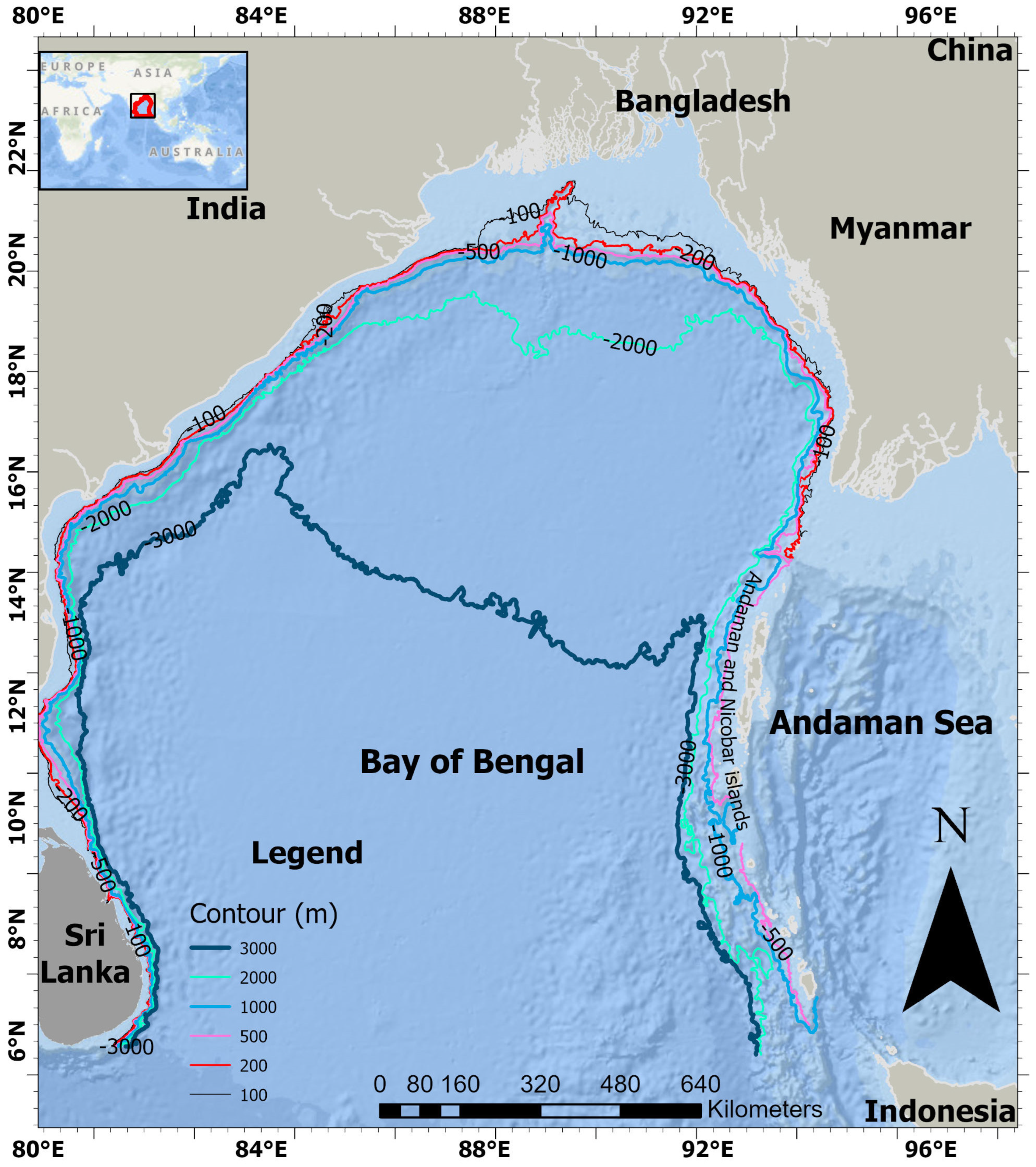



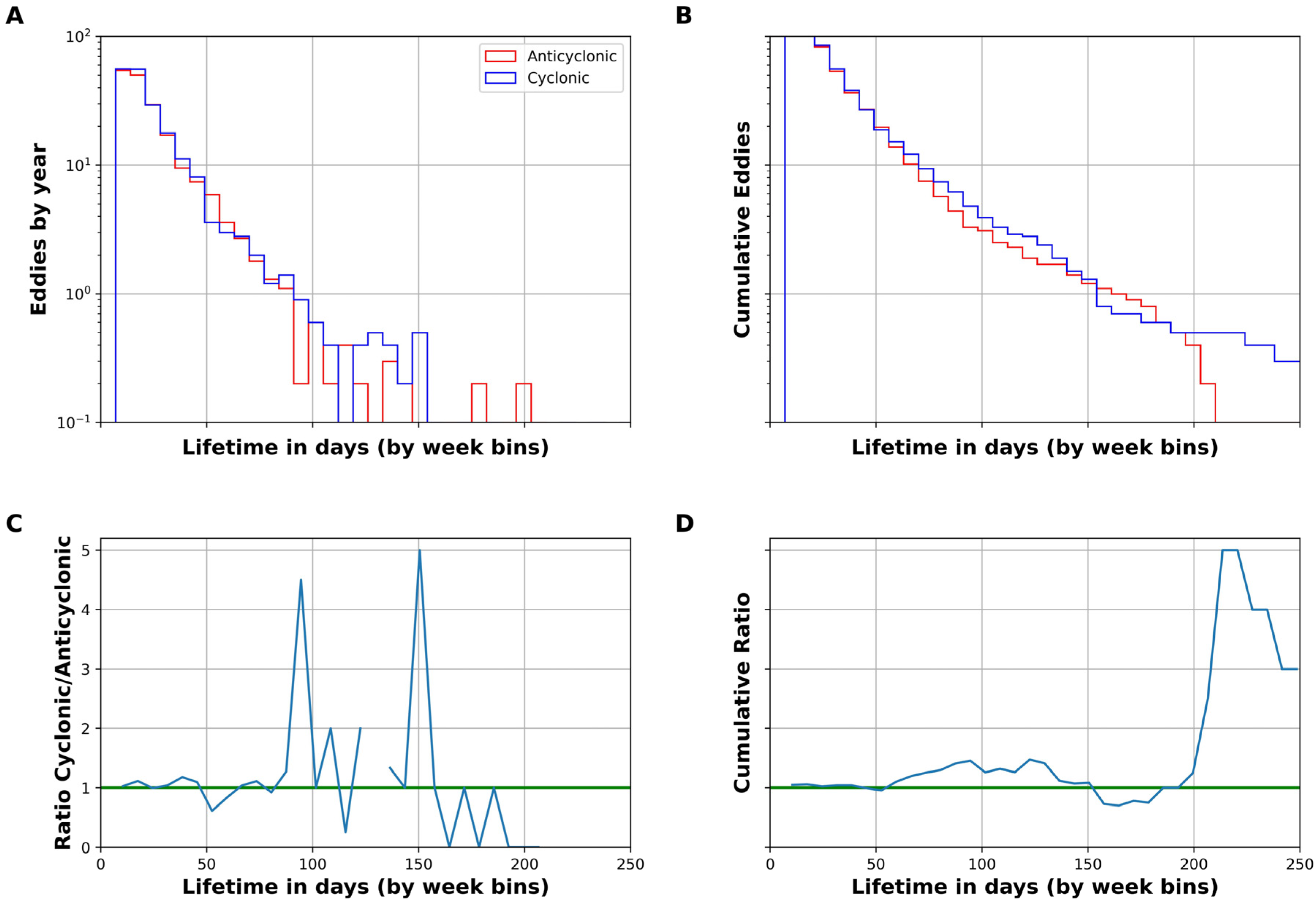
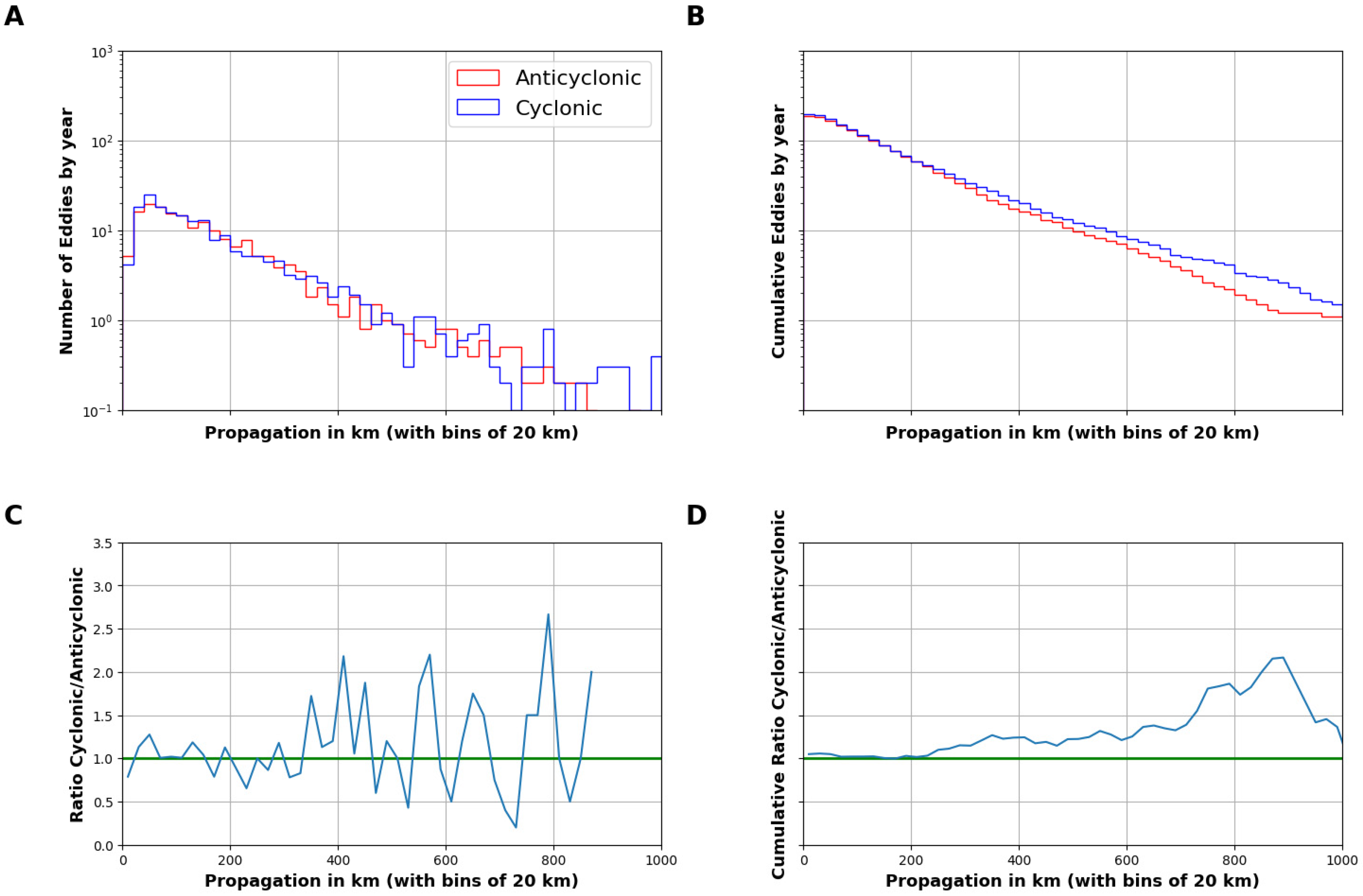
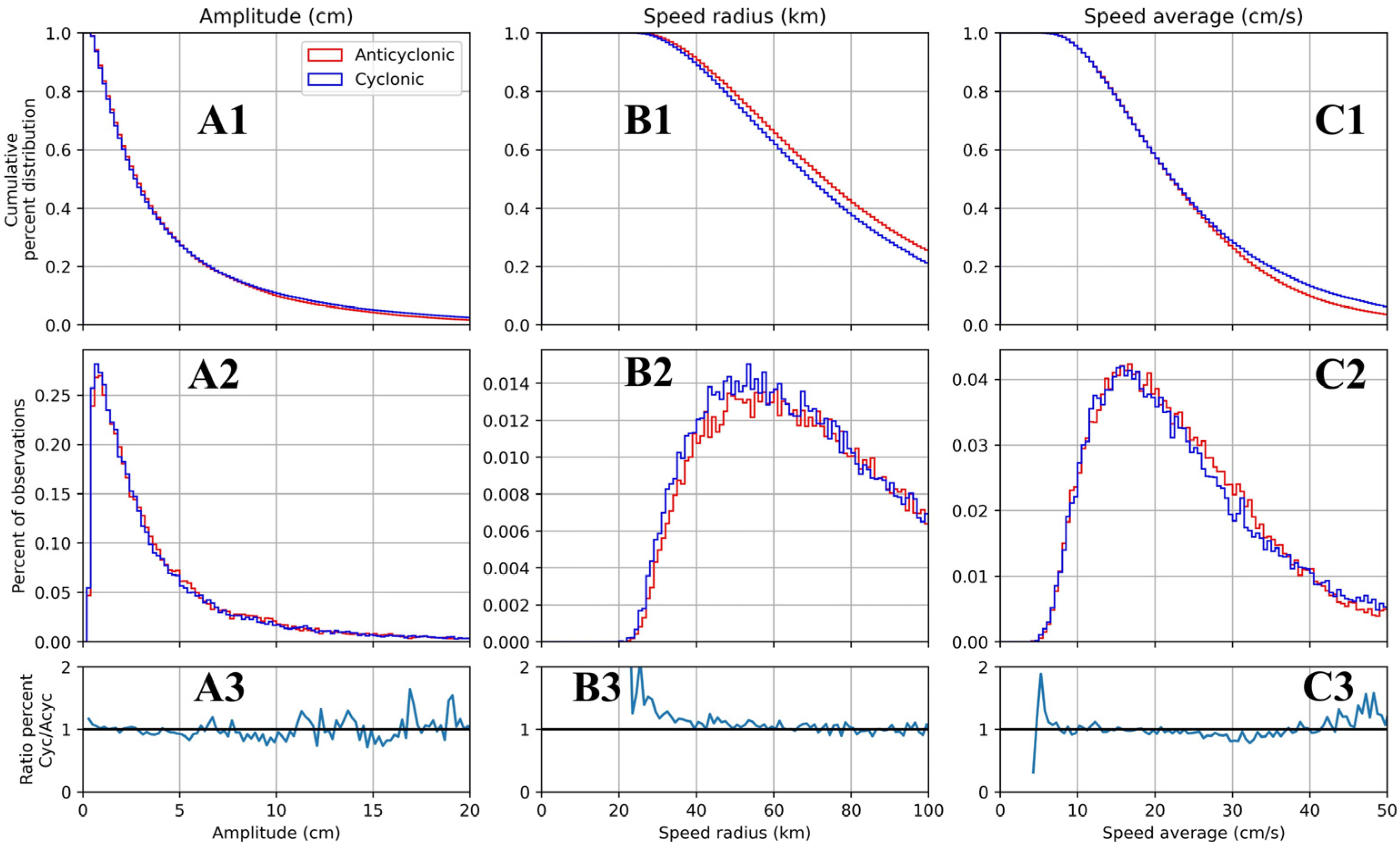
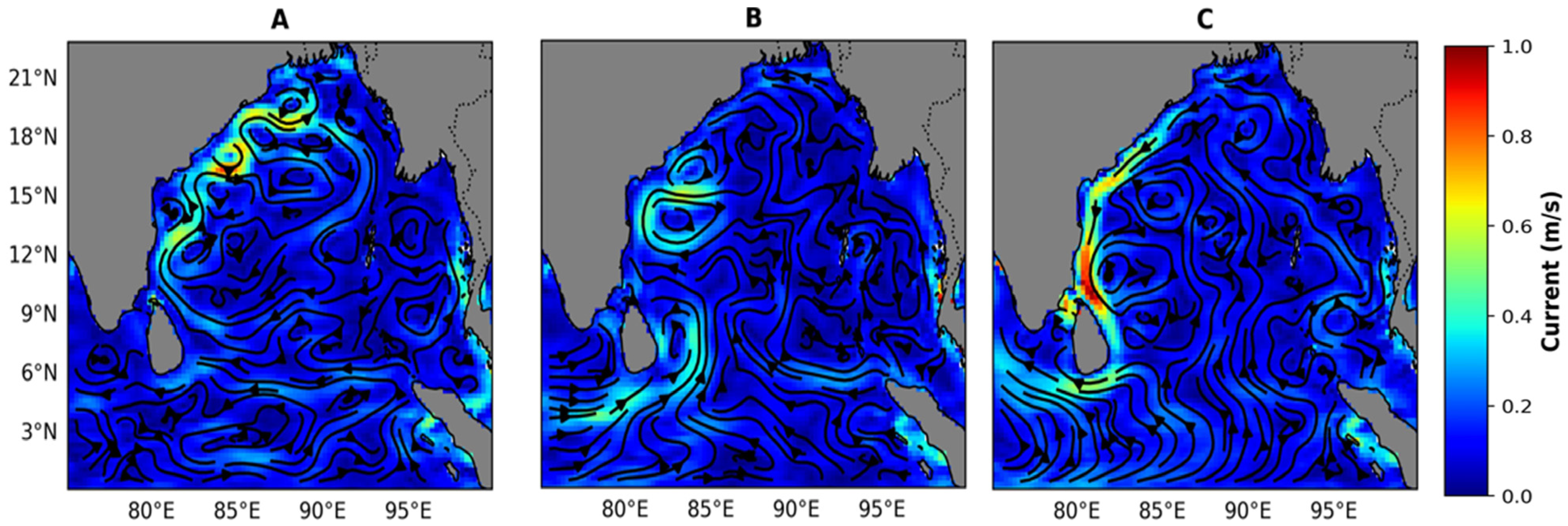
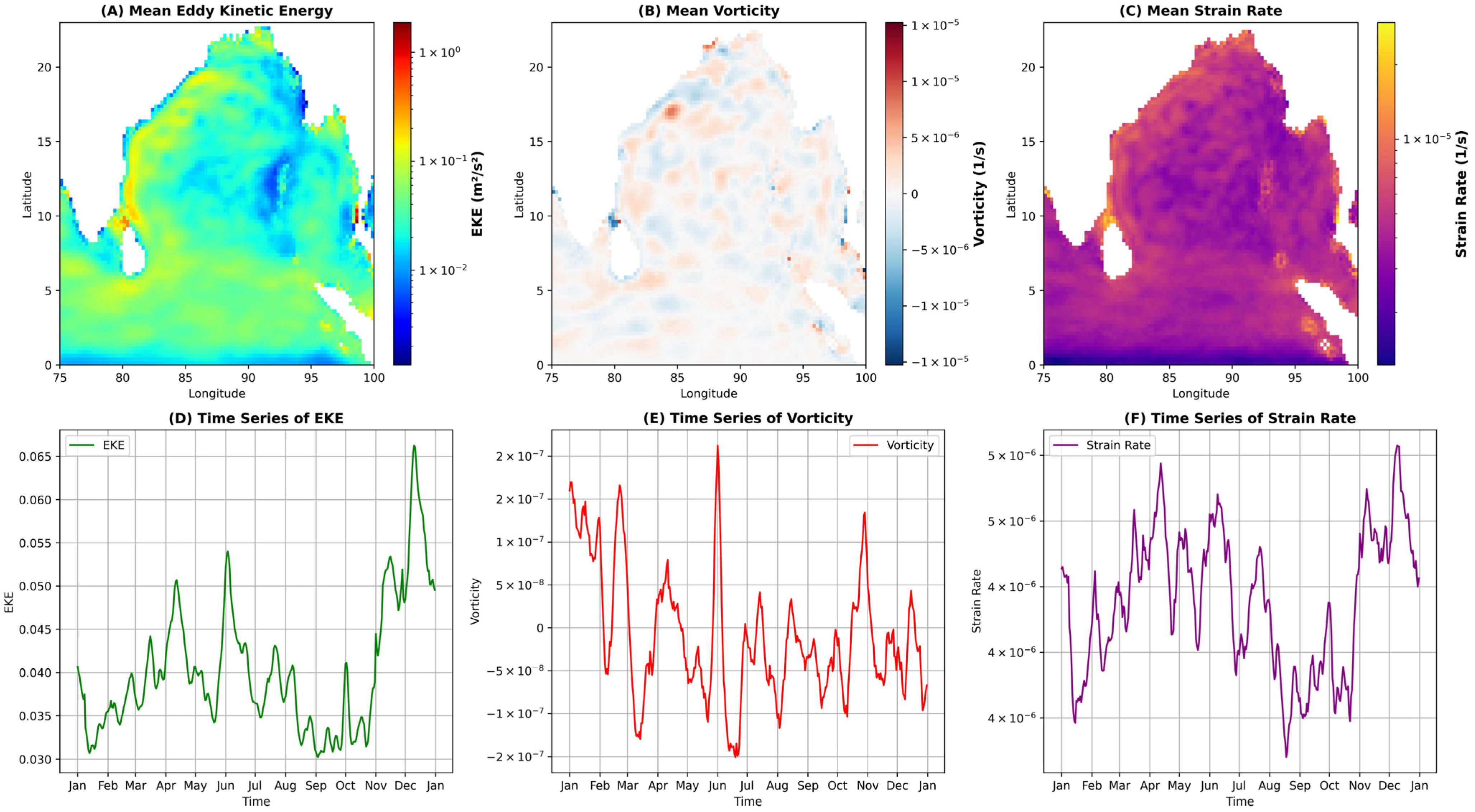
Disclaimer/Publisher’s Note: The statements, opinions and data contained in all publications are solely those of the individual author(s) and contributor(s) and not of MDPI and/or the editor(s). MDPI and/or the editor(s) disclaim responsibility for any injury to people or property resulting from any ideas, methods, instructions or products referred to in the content. |
© 2025 by the authors. Licensee MDPI, Basel, Switzerland. This article is an open access article distributed under the terms and conditions of the Creative Commons Attribution (CC BY) license (https://creativecommons.org/licenses/by/4.0/).
Share and Cite
Ahmad, H.; Jose, F.; Dash, P.; Jhara, S.I. Detection, Tracking, and Statistical Analysis of Mesoscale Eddies in the Bay of Bengal. Oceans 2025, 6, 52. https://doi.org/10.3390/oceans6030052
Ahmad H, Jose F, Dash P, Jhara SI. Detection, Tracking, and Statistical Analysis of Mesoscale Eddies in the Bay of Bengal. Oceans. 2025; 6(3):52. https://doi.org/10.3390/oceans6030052
Chicago/Turabian StyleAhmad, Hafez, Felix Jose, Padmanava Dash, and Shakila Islam Jhara. 2025. "Detection, Tracking, and Statistical Analysis of Mesoscale Eddies in the Bay of Bengal" Oceans 6, no. 3: 52. https://doi.org/10.3390/oceans6030052
APA StyleAhmad, H., Jose, F., Dash, P., & Jhara, S. I. (2025). Detection, Tracking, and Statistical Analysis of Mesoscale Eddies in the Bay of Bengal. Oceans, 6(3), 52. https://doi.org/10.3390/oceans6030052







